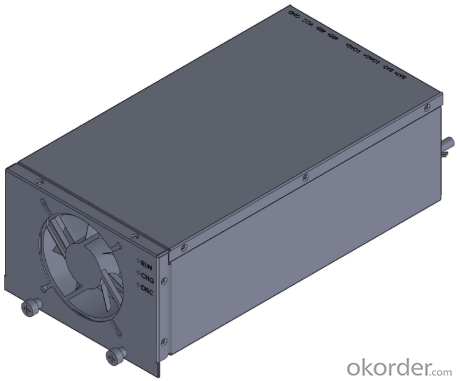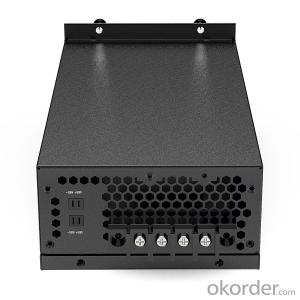MF serie solar charge controller suitable for electric cabinet
- Loading Port:
- China main port
- Payment Terms:
- TT OR LC
- Min Order Qty:
- 100 pc
- Supply Capability:
- 500 pc/month
OKorder Service Pledge
OKorder Financial Service
You Might Also Like
1. Product Characterist
1.1 Professional design of system reliability overall improvement
Semiconductor device adopt IR、TI、ST、ON and NXP etc. international well-know brands
Industrial grade MCU all digital technology, high capacity of resisiting disturbance, No aging and drifting problem
IP protection grade,no any buttons,improve the waterproof reliability furtherly
1.2 High efficiency MPPT tracking technology
MPPT tracking effiency ≥99.9%, system generation efficiency up to 98%, promote the system efficiency and save the system cost.
1.3 High conversion effiency
Charging conversion efficiency up to 98.8%
1.4 Super tiny static power consumption
No-load current consumption ≤ 35mA(24V system),≤24mA(48Vsystem)
1.5 Inteligient storage battery management
Three phase charging management, MPPT charging, constant voltage charge and float charge, significantly extends the battery life
Base on intelligent temperature compensation charge and discharge management, significantly extend more than 50% battery life
1.6 Flexible parameter setup funtion
RS485 communication,can set parameter flexiblely, various batteries compatibility
1.7 Compete protection funtion
Battery reverse protection
Solar panel reverse proction
Prevent the battery from discharging to solar panel at night
Battery low voltage protection
Battery exits low voltage protection
Output overcurrent protection
2.Product parameter
Item | Content | Model |
Unit
|
M4850 | |||
Battery Parameter | Rated system voltage | Lithium battery program setting, lead acid 24V/48V Auto | - |
Maximum charging current | 50 | A | |
Support maximum number of parallel units | 20 | Pieces | |
Charging voltage range | 20~60 | V | |
MPPT charging voltage @25°C | ≤28.8(24V), ≤57.6(48V) | V | |
Constant voltage average charging pressure @25°C | 28.8(24V), 57.6(48V) | V | |
Constant voltage floating charge @25°C | 27.6(24V), 55.2(48V) | V | |
Temperature compensation coefficient | -4mV/℃/2V | - | |
PV Parameter | PV maximum input voltage | 180 | V |
Maximum solar panel power | 1200(24V) 2400(48V) | W | |
Maximum DC input current | 10*2 | A | |
Starting voltage | 40(24V),70(48V) | V | |
MPPT tracking range | 40≤Vp≤150(24V), 70≤Vp≤150(48V)。 | V | |
System parameter | MPPT efficiency | ≥99.9% | - |
Charge conversion maximum efficiency | 98.8% | - | |
Static power consumption | ≤35(24V)≤24(48V) | mA | |
Conmunication method | RS485 | - | |
Storage/working temperature | -25~60 | ℃ | |
Storage/working humidity | 0~95%(no condensation) | RH | |
altitude | 3000 | m | |
Protection level | IP20 | - | |
Heat dissipation method | Intelligent air cooling | - | |
Certification | CE,ROSH | - | |
Size (mm) | 135*245*83 | mm |
3. Image

4. FAQ
Q:DO YOU HAVE ANY CERTIFICATION FOR YOUR PRODUCTS?
A:We have ISO9001:2015,CE、RoHS certifications for all of our products.
Q:DO YOU HAVE MOQ FOR PLACE ORDER?
A:Low MOQ,1pe for sample checking is available
- Q:What is the purpose of the battery temperature sensor on a solar controller?
- The purpose of the battery temperature sensor on a solar controller is to monitor and regulate the temperature of the battery connected to the solar system. It plays a crucial role in maintaining the longevity and efficiency of the battery. The battery temperature sensor works by measuring the temperature of the battery and sending this information to the solar controller. This data is then used by the controller to adjust the charging and discharging parameters of the battery to ensure optimal performance and protection. Temperature affects the chemical reactions that occur inside the battery, and extreme temperatures can significantly impact its overall capacity and lifespan. If the battery becomes too hot, it may experience accelerated degradation or even thermal runaway, which can lead to permanent damage. On the other hand, if the battery becomes too cold, its internal resistance increases, reducing its ability to deliver power efficiently. By constantly monitoring the battery temperature, the solar controller can adjust the charging voltage and current to prevent overcharging or over-discharging, which can cause damage. It can also adjust the charging algorithm to optimize the charging process based on the temperature conditions, ensuring that the battery operates within its safe temperature range. In addition to protecting the battery, the temperature sensor also helps improve the overall efficiency of the solar system. By adjusting the charging parameters based on the temperature, the solar controller can maximize the charging efficiency, ensuring that the battery is charged effectively without wasting excess energy or causing unnecessary stress on the battery. Overall, the battery temperature sensor on a solar controller serves the vital purpose of monitoring and regulating the temperature of the battery, protecting its longevity, and optimizing the performance and efficiency of the solar system.
- Q:What is the maximum voltage drop across a solar controller?
- The maximum voltage drop across a solar controller depends on its design and specifications. However, in general, it is recommended to have a maximum voltage drop of around 0.2 to 0.3 volts for efficient and optimal performance.
- Q:Can a solar controller be used with a solar-powered sports facility?
- Yes, a solar controller can be used with a solar-powered sports facility. A solar controller is an essential component that regulates the charging and discharging of batteries in a solar power system, ensuring optimal performance and preventing damage. In a solar-powered sports facility, the solar controller would help manage the flow of energy from the solar panels to power the facility's electrical needs and store any excess energy in batteries for later use.
- Q:How does a solar controller handle the protection against ground faults?
- A solar controller handles protection against ground faults by continuously monitoring the electrical current flow between the solar panels and the battery or grid. If a ground fault occurs, where the current leaks to the ground instead of following the intended path, the controller quickly detects the imbalance and interrupts the circuit to prevent any potential damage or electrical hazards.
- Q:Can a solar controller be used with a solar-powered airport or seaport?
- Yes, a solar controller can be used with a solar-powered airport or seaport. A solar controller regulates the flow of energy from solar panels to the batteries or electrical grid, ensuring optimal performance and preventing damage. It is an essential component in managing and maximizing the efficiency of solar power systems, making it compatible and beneficial for use in solar-powered airports or seaports.
- Q:How long is the lifespan of a typical solar controller?
- The lifespan of a typical solar controller can vary depending on several factors. On average, a well-maintained and high-quality solar controller can last anywhere from 10 to 15 years. However, there are instances where solar controllers have been known to last even longer, nearing 20 years or more. The longevity of a solar controller can be influenced by factors such as the brand and quality of the controller, the operating conditions it is subjected to, and the level of maintenance and care provided. Higher quality controllers from reputable brands tend to have better build quality and durability, resulting in a longer lifespan. The operating conditions also play a vital role in determining the lifespan of a solar controller. Extreme temperatures, humidity, and exposure to harsh weather conditions can impact the longevity of the controller. Controllers installed in regions with more moderate climates and protected locations generally tend to last longer. Proper maintenance and care can significantly extend the lifespan of a solar controller. Regularly inspecting and cleaning the controller, ensuring proper ventilation, and protecting it from excessive moisture or dust can help prolong its life. It is also essential to follow the manufacturer's guidelines for maintenance and avoid overloading the controller beyond its rated capacity. Ultimately, while the average lifespan of a solar controller is around 10 to 15 years, several factors can influence its longevity. By investing in a high-quality controller, providing suitable operating conditions, and practicing regular maintenance, it is possible to extend the lifespan and maximize the efficiency of a solar controller.
- Q:Can a solar controller be used with solar-powered public transportation systems?
- Yes, a solar controller can be used with solar-powered public transportation systems. A solar controller is designed to regulate and optimize the charging and discharging of batteries connected to solar panels. In solar-powered public transportation systems, solar controllers can effectively manage the energy flow from the solar panels to the batteries, ensuring efficient utilization of solar power for the transportation system.
- Q:How does a solar controller handle overvoltage protection?
- A solar controller handles overvoltage protection by monitoring the voltage level of the solar panels or batteries connected to it. If the voltage exceeds a certain threshold, the controller automatically shuts off the charging process to prevent damage to the batteries or other connected devices. This protection mechanism ensures that the system operates within safe voltage limits and extends the lifespan of the equipment.
- Q:How do PWM solar controllers work?
- PWM (Pulse Width Modulation) solar controllers regulate the charging of batteries in solar power systems. They work by rapidly switching the solar panel's output on and off, creating a pulsating current that is then smoothed out and regulated to charge the batteries efficiently. This method ensures that the batteries are charged at an optimal rate, preventing overcharging and extending their lifespan.
- Q:Can a solar controller be integrated with a solar monitoring system?
- Yes, a solar controller can be integrated with a solar monitoring system. By connecting the solar controller to the monitoring system, it allows for real-time monitoring and analysis of the solar system's performance, including factors such as power output, battery charge status, and system efficiency. This integration enables effective management and optimization of the solar system for improved energy generation and overall performance.
1. Manufacturer Overview |
|
|---|---|
| Location | |
| Year Established | |
| Annual Output Value | |
| Main Markets | |
| Company Certifications | |
2. Manufacturer Certificates |
|
|---|---|
| a) Certification Name | |
| Range | |
| Reference | |
| Validity Period | |
3. Manufacturer Capability |
|
|---|---|
| a)Trade Capacity | |
| Nearest Port | |
| Export Percentage | |
| No.of Employees in Trade Department | |
| Language Spoken: | |
| b)Factory Information | |
| Factory Size: | |
| No. of Production Lines | |
| Contract Manufacturing | |
| Product Price Range | |
Send your message to us
MF serie solar charge controller suitable for electric cabinet
- Loading Port:
- China main port
- Payment Terms:
- TT OR LC
- Min Order Qty:
- 100 pc
- Supply Capability:
- 500 pc/month
OKorder Service Pledge
OKorder Financial Service
Similar products
New products
Hot products
Hot Searches
Related keywords






























